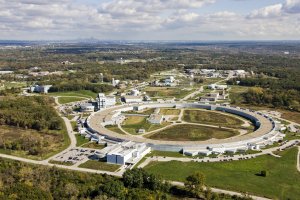Advances in energy conservation, better materials for frontier technologies and new economic engines and breakthroughs in understanding diseases: these are just a few of the potential discoveries, both basic and applied, to be enabled by an upgrade to the Advanced Photon Source (APS) at the U.S. Department of Energy's (DOE) Argonne National Laboratory.
DOE today announced formal approval for conceptual design of the APS upgrade, the first in a series of major milestones that the project must meet under DOE's project management regimen.
 The Advanced Photon Source has received approval for the first stage of an upgrade to the facility
The Advanced Photon Source has received approval for the first stage of an upgrade to the facility
"This is a major step in securing America's scientific future by taking an already premier facility and preparing it to meet the next generation of scientific needs and discoveries," said Argonne Director Eric Isaacs.
The upgrade will be more cost-effective than building a new facility. It will make revolutionary improvements in performance needed to address the sustainable energy and health research needs of the future. The upgrade will also add new X-ray facilities, make existing X-ray facilities 10 to 100 times more powerful and almost double the number of experiments that can be carried out in a year. In addition, the upgrade is expected to create new high-tech jobs.
Researchers using the APS have been at the forefront of scientific discovery since its creation in the 1990s. At present, the APS serves the experimental needs of more than 3,500 researchers each year, more than any other scientific user facility in the Western Hemisphere.
The Advanced Photon Source uses high-energy X-ray beams to peer deep into the atomic and molecular structures of materials and living organisms as small as a few nanometers. The APS has been providing the U.S. scientific community with the expertise and research tools that enable breakthroughs such as improved battery technologies, an unprecedented understanding of how engine fuel injectors function, treatment for the human immunodeficiency virus and other diseases, the creation of new nanomaterials and advances in nanobiology, among other developments.
"Data collated at the APS was used by the scientists who won the 2009 Nobel Prize in chemistry," said Don Levy, Vice President for Research and for National Laboratories at the University of Chicago. UChicago Argonne LLC manages Argonne for DOE. "A new world of discoveries will be possible because of the upgrade," he said.
"The scientific vision which drove upgrade planning is the need to image real materials under real conditions in real time, with resolution far better than is available today," said APS Director and Argonne Associate Lab Director for Photon Sciences J. Murray Gibson. "This is key to solving the materials needs for sustainable energy and understanding the hierarchy of life to combat disease. The upgrade will allow the Advanced Photon Source to meet the needs of today's and tomorrow's scientists without the need for building an entirely new facility."
The announcement, at the APS users meeting at Argonne, was made by Dr. Pedro Montano, Director of the Scientific User Facilities Division of the Office of Basic Energy Sciences within DOE's Office of Science, which supports the APS.
The Upgrade at a Glance
Accelerator-based X-ray source innovations
Record brightness for penetrating X-rays at 25 kiloelectronvolts (keV) and above using long straight sections, higher beam current and pioneering superconducting undulators; transverse radio-frequency deflection cavities to generate unique high-repetition-rate, 1-picosecond-duration X-ray pulses. A picosecond is one trillionth of a second.
Unique X-ray capabilities and new beamlines
Long imaging beamlines, nanometer focusing optics for penetrating X-rays, short-pulse X-rays, high magnetic fields, inelastic scattering, phase contrast and nanobeams in realistic environments. These capabilities will answer key scientific questions and will result in ultrahigh phase contrast of more than three orders of magnitude, ultrahigh energy resolution in the range of microvolts, better than a nanometer spatial resolution and time resolution to a picosecond.
Optimized and expanded capabilities
The APS drove developments that require new approaches today, but which could not be anticipated in the 1990s. Demand for increasing capability and scope requires a new access model that supports world-leading, one-of-a-kind instruments, a change from the collaborative-access-team model of twentieth-century light sources. All APS beamlines will be optimized in the upgrade with higher performance to match scientific demand, almost doubling experimental capacity.
Normal operating hours will be sustained with relatively minor APS user disruption during the upgrade project.